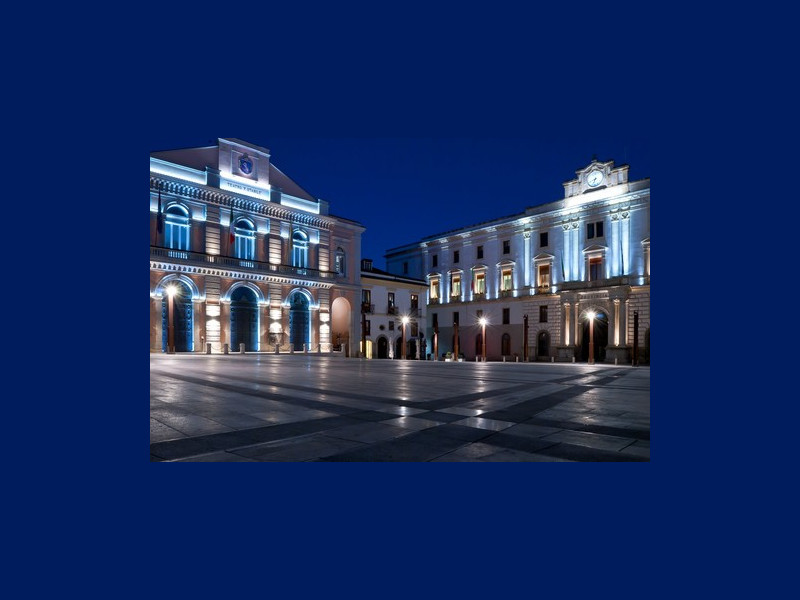Destinazioni - Comune
Potenza
Where
Potenza
Potenza (Italian: [poˈtɛntsa] ( )) is a city and comune in the Southern Italian region of Basilicata (former Lucania). It is the capital of the province of Potenza and the Basilicata region.
The city is the highest regional capital and one of the highest provincial capitals in Italy, overlooking the valley of the Basento river in the Apennine Mountains of Lucania, east of Salerno. Its territory is bounded by the comuni of Anzi, Avigliano, Brindisi Montagna, Picerno, Pietragalla, Pignola, Ruoti, Tito, and Vaglio Basilicata.
History
Ancient times
The first settlement of Potentia was probably located at a lower elevation than at present, some 10 kilometres (6 miles) south of today's Potenza.
The Lucani of Potenza sided against Rome's enemies during the latter's wars against the Samnites and the Bruttii. Subjugated during the 4th century BC (later gaining the status of municipium), the Potentini rebelled after the Roman defeat at Cannae in 216 BC. However, the Battle of the Metaurus marked the end of any Carthaginian aspirations in Italy, and Potentia was reconquered by the Romans and reduced to the status of military colony.
Middle Ages
In the 6th century, the city passed to the Lombard Duchy of Benevento. Incursions by Saracens raiders menaced the city until the Norman conquest of southern Italy secured the area. In the 12th century, Potenza became an episcopal see. In 1137, the city hosted Pope Innocent II and Emperor Lothair II during their failed attempt to conquer the Norman kingdom. In 1148 or 1149 in Potenza, Roger II of Sicily hosted king Louis VII of France, whom the Norman fleet had freed from the Saracens. After pillaging by Emperor Frederick II, the city remained loyal to the Hohenstaufen: as a result, it was almost totally destroyed by Charles I when the Angevin lord conquered the Kingdom of Sicily. On December 18, 1273, an earthquake further devastated the city.
Modern age
In the following years, the city existed quietly under various feudal owners. Potenza was the site of riots against Spanish domination, and in 1694 it was almost completely destroyed by another earthquake.
With the declaration of the Neapolitan Republic in 1799, Potenza was one of the first cities to rebel against the king. After temporary Bourbon repression, the city was conquered by the French army in 1806, and declared the capital of Basilicata. King Joachim Murat improved the city's living conditions and administration, and some urban improvements were introduced for the visit of Ferdinand II in 1846. A revolt broke out in 1848 and was again put down by Bourbon forces, and a third devastating earthquake followed in 1857. Potenza rebelled for the last time in 1860, before Garibaldi's revolutionary army brought about the unification of Italy.
In September 1943, the city suffered heavy Allied bombing. In 1980, another strong earthquake struck Potenza.
Main sights
The Duomo (Cathedral) of San Gerardo, renovated in the 18th century. The cathedral still houses the rose window and the apse from the original 12th-century structure.
The Church of San Francesco, founded in 1274. The portal and the bell tower date from the 15th century. The church houses the De Grasis sepulchre and a Madonna in Byzantine style (13th century).
The Torre Guevara, the last remnant of the old castle. It is now used to stage art exhibitions.
The Palazzo Loffredo, a 17th-century noble residence. it is now the seat of the "Dinu Adamesteanu" National Archaeological Museum.
Three gates of the old city walls, now demolished. The gates are the Porta S.Giovanni, the Porta S.Luca and the Porta S. Gerardo.
The Romanesque church of San Michele (11th-12th centuries).
The Church of Santa Maria del Sepolcro.
The ruins of a Roman villa in the Poggio Tre Galli quarter.
Geography
Climate
Potenza experiences a borderline Mediterranean/oceanic climate (Köppen climate classification Csb/Cfb).
Potenza (pōtānˈtsä) [key], city (1990 pop. 65,714), capital of Basilicata and of Potenza prov., S Italy, in the Apennines. It is an agricultural, commercial, and light industrial center. Founded in the 2nd century BC by the Romans, Potenza was later incorporated (847) into the principality of Salerno. Of note in the city is the Church of San Francesco (begun 1274).
Landscape
Transportation
Potenza is a rail junction on the main line from Salerno to Taranto, managed by FS Trenitalia; it has also a connection to Altamura, served by the Ferrovie Appulo Lucane regional company. The city's main station, which was originally named Potenza Inferiore, is now known as Potenza Centrale.
The nearest airports are:
Salerno-Pontecagnano QSR 85 km (53 mi)
Foggia-Gino Linosa FOG 101 km (63 mi)
Bari-Palese BRI 130 km (81 mi)
Notable people
Saint Gerard of Potenza (...-1118) - bishop
Lucia Lauria Vigna (1896–2009) - supercentenarian
Tanio Boccia (1912–1982) - film director
Emilio Colombo (1920) - politician
Ruggero Deodato (1939) - film director
Francesco Colonnese (1971) - former football player
Giovanni Frezza (1972) - film actor
Wally Buono (1950) - BC Lions football club head coach (CFL)
Donato Sabia (1963) - former middle distance runner
Anna Bonitatibus (...) - opera singer
Vito Postiglione (1977) - racing driver
Rocco Sabato (1982) - football player
Antonio Giosa (1983) - football player
International relations
Twin towns — Sister cities
Potenza is twinned with:
Denver, USA
Focşani, Romania
References
External links
Official website
Page at Comuni Italiani
Battle of Potenza at canadiansoldiers.com

